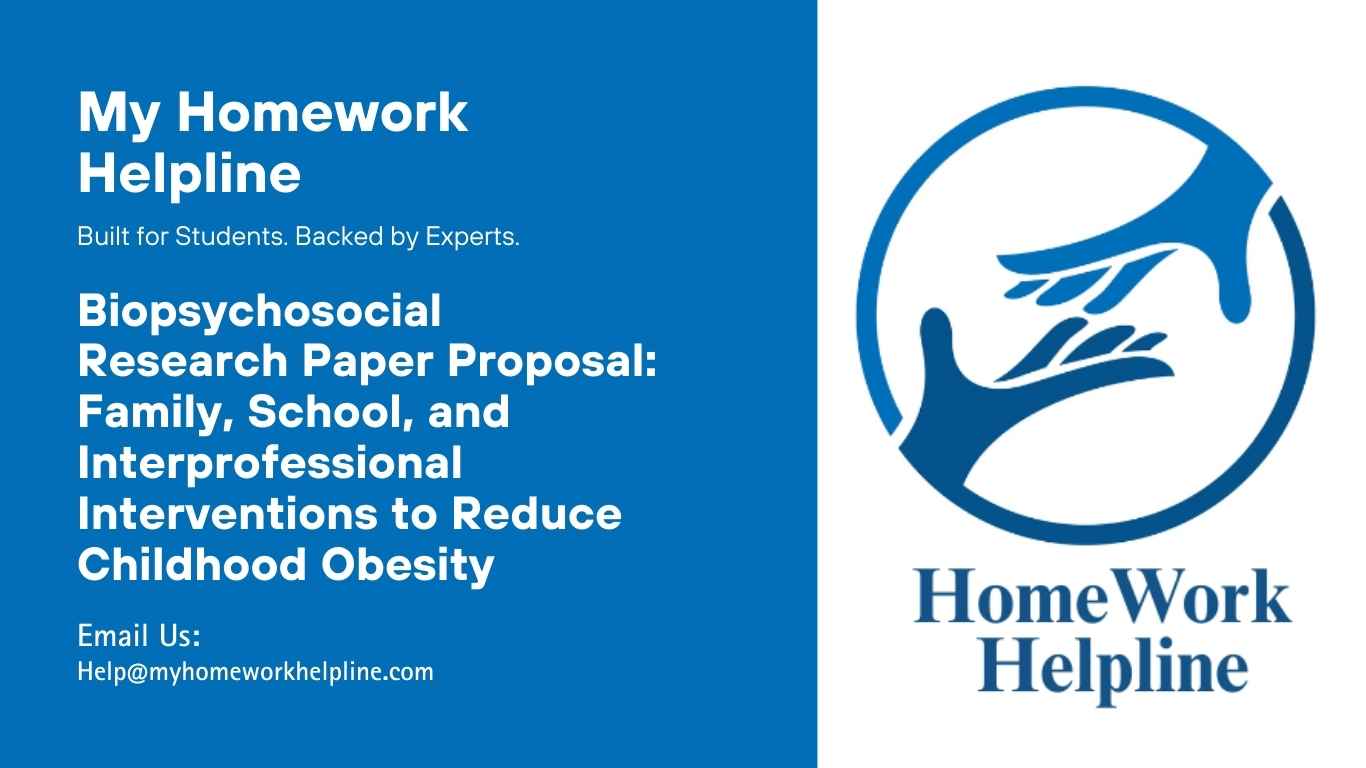Biopsychosocial Population Health Policy Proposal Research Paper: Reducing Childhood Obesity
Obesity among children is a serious health concern that requires intervention. The prevalence of obesity in children and adolescents aged 2-19 years in the U.S. was 18.5% in 2017-2018 (Tsoi, et al., 2022). Childhood obesity has several negative health consequences, both in the short term and long term such as heart disease and breathing problems. Additionally, obese children are more likely to be subjected to social and psychological problems such as bullying, depression, and low self-esteem.
Children maintaining a healthy weight has a lower risk of developing chronic diseases, and are more likely to have a good physical and mental health outcome. Furthermore, children introduced to healthy habits early in life are more likely to continue these habits into adulthood, which can further reduce their risk of chronic disease. The proposed policy, therefore, seeks to reduce the occurrence of obesity among children aged 5-14 years in the target population by 10% over the next 5 years. The policy emphasizes an integrated approach to healthcare by addressing the biological, psychological, and social determinants of health.
Struggling with your population health policy proposal research paper on childhood obesity? My Homework Helpline provides expert assignment support and homework assistance, delivering human-written, plagiarism-checked papers with detailed reports. Whether you’re tackling complex policy frameworks, family interventions, or interprofessional strategies, our team helps you craft a standout research paper proposal at Nursing Homework Helpline, empowering future nurses and public health professionals to excel in their coursework and make an impact in healthcare.
Family and Children education and counselling programme on physical activity and nutrition
Education and counselling programs on Physical activity and nutrition can help families to create an environment that promotes healthy eating and regular exercise. The Nutrition and Physical Activity Education and Counselling Program for Children and Families (NAECP) aims at promoting healthy behaviours, including improved dietary habits and increased physical activity among children and families (WHO, 2018). This program can be implemented in healthcare settings, community centres, schools, or other relevant settings. These programs can provide families with education and counselling on nutrition, physical activity, and lifestyle behaviours, as well as provide access to resources and activities to promote healthy habits (Willeboordse, et al, 2022). They can also provide education on making healthy food choices, how to read food labels, how to cook healthy meals, how to be physically active, how to set goals, and how to motivate and support one another.
The impact of the NAECP, however, may be limited due to factors outside of the program itself, such as the broader food environment and the availability of safe spaces for physical activity. For example, a family may not have access to healthy foods or safe outdoor play areas, which could make it difficult to implement the recommendations of the NAECP. The article (Kim, 2021) critiques the tendency of education and counselling on nutrition and physical programs to focus on individual behaviour change, rather than addressing systemic issues that contribute to poor nutrition and physical activity habits. The author argues that blaming parents for their children’s health problems can be stigmatizing and unhelpful, and that a more effective approach would be to address issues such as food deserts, lack of safe play spaces, and inadequate public transportation.
School-Based Interventions to Increase Physical Activity
School-based interventions to reducing childhood obesity can be enhanced by partnerships with community organizations, healthcare providers, and policymakers. Interventions should be tailored to the target population, considering cultural and socioeconomic factors (WHO, 2018).The program will aim to increase physical activity levels among students by incorporating physical activity into the classroom setting. Schools can increase the amount of physical education that students receive during the school day by providing more time for physical education classes or offering extra-curricular activities such as sports teams (Willeboordse, et al, 2022). Schools can also provide access to safe outdoor spaces such as playgrounds, parks, and running tracks for students to use to exercise during their free time. Additionally, schools can encourage students to walk or bike to school by providing safe routes and by offering incentives such as prizes or special recognition.
School-based interventions have been found to be effective in increasing physical activity and reducing obesity among children when implemented with a comprehensive and coordinated approach that involves multiple stakeholders. However, some studies argue that schools may not have the resources to implement physical activity programs, such as lack of equipment, space, and staff. Others may argue that schools should focus on academic priorities rather than physical activity, which they may see as a lower priority. According to Jacob & Hardy-Johnson (2021) found out that the effect of school-based interventions on reducing BMI in children was small and not statistically significant.
Family-Based Interventions
Family-based interventions are most effective when they are tailored to the needs of the family and target population. Cultural sensitivity and input from families are very important in this program development. Environmental factors that may impact families’ ability to make healthy choices should also be taken into account (Merrotsy, et al, 2019). Components of family-based care include nutrition education, cooking and meal planning support, physical activity promotion, behavioural modification, and support and community resources. These components aim to encourage healthy eating habits, engage families in physical activity, identify and modify unhealthy habits, and provide support and resources for healthy lifestyle changes.
Psychological Interventions to Address Issues Such as Self-esteem and Body Image
Psychological interventions for children with obesity should be tailored to the individual child’s needs and developed with input from the child and their family. They should be provided in a supportive and non-judgmental environment. Cognitive-behavioural therapy (CBT), support groups, mindfulness-based interventions, family-based therapy, and education and empowerment are some of the components of psychological interventions (Gow, et al., 2020). These interventions aim to improve self-esteem and body image, help children make healthy lifestyle changes, manage stress and negative emotions, and provide positive support and reinforcement for healthy behaviours.
Role of the interprofessional team in reducing obesity in children
Interprofessional teams are critical in reducing obesity in children by taking a comprehensive and coordinated approach. Team members with clinical expertise can assess and diagnose obesity, while nutritionists, dietitians, physical therapists, and exercise specialists can provide education on healthy eating habits and physical activity promotion. Psychologists and counsellors can provide psychological support to address issues related to self-esteem and body image.
Interprofessional interventions can reduce the cost of healthcare by preventing or treating obesity-related comorbidities. They can also reduce the need for hospitalization and expensive medical procedures. Furthermore, they can improve productivity by enhancing children’s academic performance and reducing absenteeism from school. Research has shown that interprofessional interventions can be effective in reducing child obesity. For example, a review of interprofessional interventions for paediatric obesity (Brodar, et al, 2021) found that these interventions were associated with significant reductions in BMI and improvements in physical activity and dietary intake.
The success of interprofessional interventions in reducing child obesity can be influenced by several factors, such as the intensity and duration of the intervention, the target population, and the community context (Merrotsy, et al, 2019). Therefore, careful planning and implementation of interprofessional interventions are essential to achieve the desired outcomes. By involving multiple healthcare and non-healthcare professionals, interprofessional interventions can address the complex factors that contribute to child obesity, resulting in better health outcomes, and more efficient use of healthcare resources
As healthcare professionals, it is our responsibility to encourage healthy behaviours and reduce the risk of chronic diseases in our patients. One of the most effective ways to do this is by addressing obesity in children. We must take a comprehensive and coordinated approach, involving multiple healthcare professionals with diverse expertise, to ensure that interventions are tailored to the needs of each individual child. This will help us to achieve better health outcomes and improve the overall health of the population. By working together, we can make a significant impact on reducing obesity in children and promoting a healthier future for all.
References
Brodar, K. E., Pennington, A. P., & Dickinson, L. M. (2021). Interprofessional Interventions for Pediatric Obesity: A Systematic Review. Journal of Interprofessional Education & Practice.
Gow, M., Tee, M. S., Garnett, S. P., Baur, L. A., Thomas, S., & Lister, N. (2020). Pediatric obesity treatment, self‐esteem, and body image: A systematic review with meta‐analysis.
Jacob, C. M., & Hardy-Johnson, P. L. (2021). Effect of school-based physical activity interventions on body mass index in children: a meta-analysis. International journal on behavioural nutrition and physical activity.
Kim, L. (2021). The Problem with Blaming Parents: A Critique of Nutrition and Physical Activity Education and Counselling Programs. Journal of Health Education Research.
Merrotsy, A., McCarthy, A., Flack, J., & Coppinger, T. (2019). Obesity Prevention Programs in Children: The Most Effective Settings and Components. A Literature Review. Journal of Obesity and Chronic Diseases.
Tsoi, M.-F., Li, H.-L., Feng, Q., Cheungb, C.-L., Cheung, T. T., & Bernard M.Y. Cheunga. (2022). Prevalence of Childhood Obesity in theUnited States in 1999–2018: A 20-YearAnalysis.
WHO. (2018). Promoting Physical activity in the Education sector:Current status and success stories from the European Union Member States of the WHO European Region. World Health Organization(WHO).
Willeboordse, M., Bartelink, N. H., Assema, P. v., & Savelberg, M. (2022). Battling the obesity epidemic with a school-based intervention: Long-term effects of a quasi-experimental study. PloS one, 17. Retrieved from https://doi.org/10.1371/journal.pone.0272291

